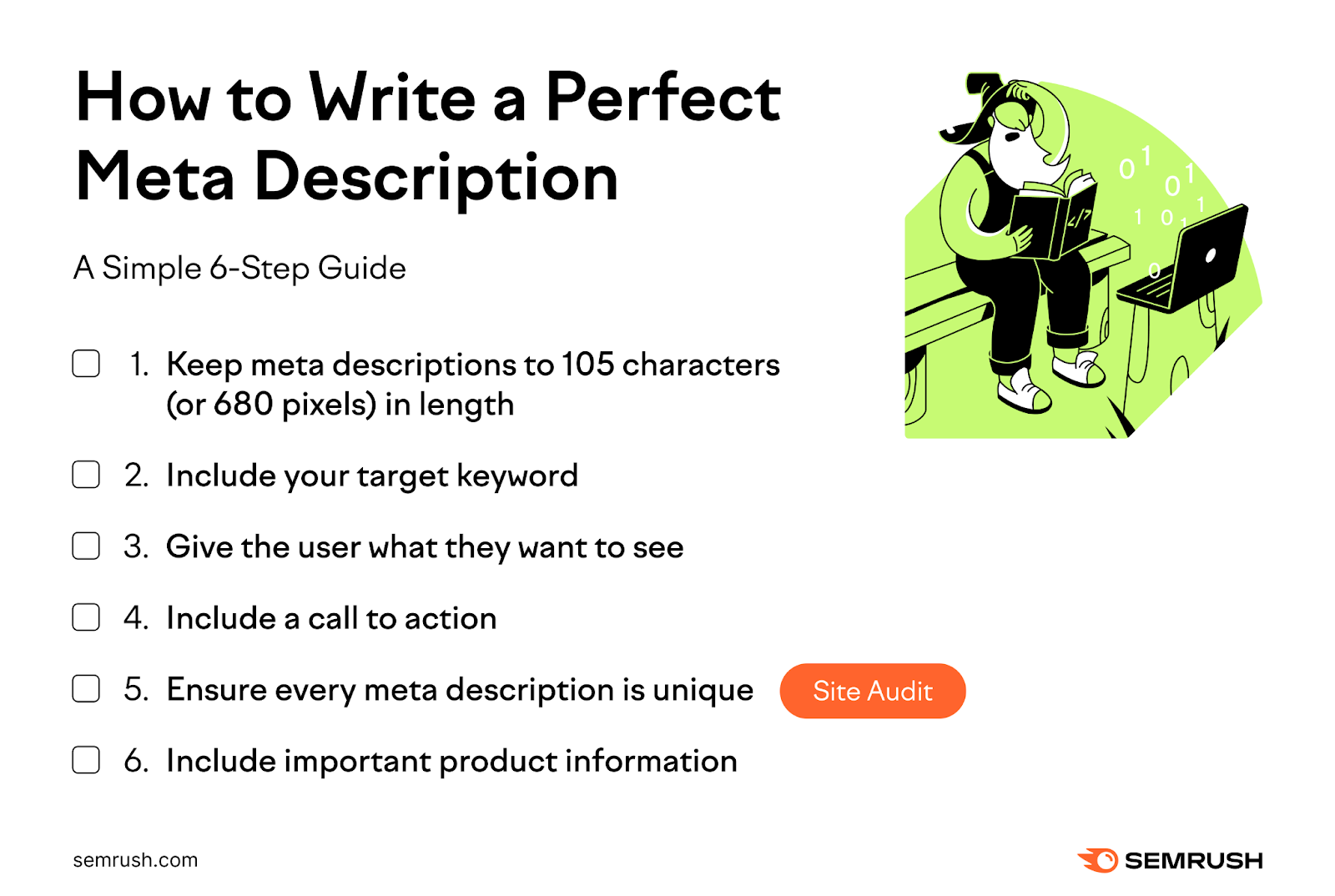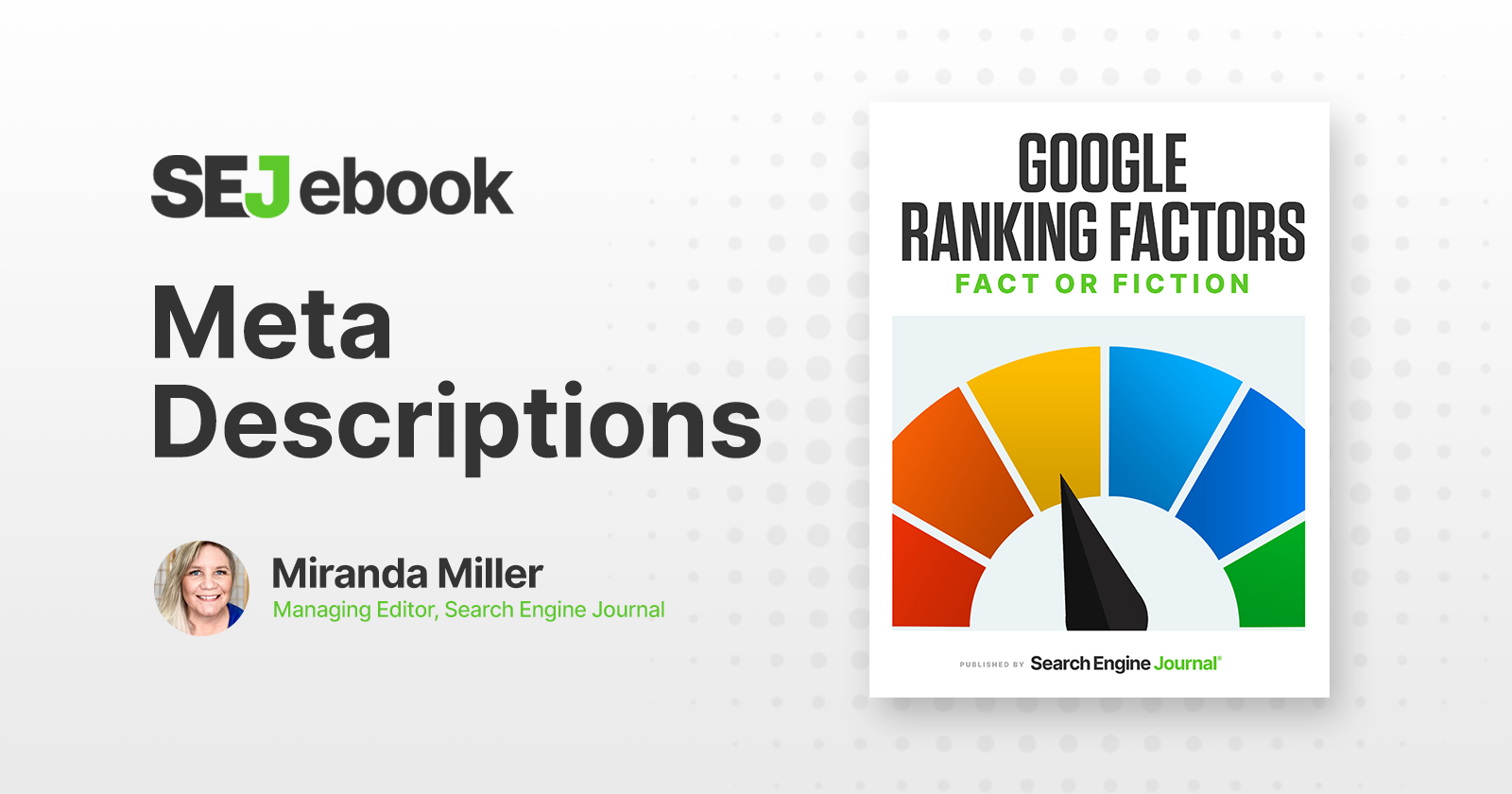What is Google Updates Documentation On Meta Descriptions?
A meta description element often provides users with a succinct, pertinent explanation about what a particular website is about, educating and engaging them. They operate as a sales pitch, persuading the user that page contains all the information they need.
An HTML tag known as a “meta description” summarizes the information on a webpage. It is the short description that appears on search engine results beneath the page title and is typically 160 characters or less long.
Why are meta descriptions important ?
Meta descriptions are important because they let Google know what is on your website. If Google can read and comprehend the information in your meta description, your website will have a greater chance at responding to search requests.
Google will show a fragment of content in the first sentence of your page if you don’t have included a meta description. If a search term appears in that text, it will be bolded. Although this isn’t a bad thing, by leaving out a meta description, your miss the chance to specifically target browsers with your message.
However, a page’s button rate (Click through rate) in Google SERPs may be impacted by the meta description, which may favorably affect a page’s potential to rank. The searcher’s chance to assess whether the material is likely to be related to their query and include the information they’re looking for is provided by these brief paragraphs, which are the webmaster’s chance to “advertise” material to searchers.
It’s crucial to put some thought into writing your meta descriptions because they can have a significant impact on user behavior and indirectly affect search rankings.
Tips for meta descriptions
Google states that a meta description must inform visitors about the website’s topic. Based on the information in a meta description, the search tool prioritizes the results.
Consider your website’s meta description as a sales presentation. Verify that it accurately captures what is on the site and provides context as to why the visitor will find it beneficial. Readers are likely to click away if they don’t find whatever the meta description claims they will find.
-
Respond to the query
Google is probably being used by people to look up information. Consider what they are seeking and how your material may help by trying to put yourself in their shoes.
Put a benefit or solution to that question in the meta description. Let’s use an example where your website provides visitors with free templates for SOP creation.
-
Mention an answer to the problem
Give your readers a solution to the issue they’re seeking to address. For example, if you’re creating a listicle collection of useful CRM software for your site, indicating how many things are included in the post or why readers will find the content useful.
Keep in mind that the meta description is your page’s “elevator pitch”; use it to persuade people to click on your link by selling the information in your post. This synopsis details the range of possibilities that readers will encounter as well as the importance of their comprehension.
-
The description should be brief
Your viewers will be educated in the page’s body, therefore the meta description does not have to be extensive. Give visitors a brief overview of the page’s content or highlight its most important point. No more than 160 characters should be used in meta descriptions. A good method for figuring out the length of a meta description is to draft a tweet.
-
Avoid using keywords excessively
Although it should contain keywords, your meta description must come organically to the reader. Readers could not grasp your meta description if you overused keywords merely to attain a high rank. A visitor may quit your page because of a description that is difficult to grasp.
-
Be interesting to readers and distinctive
If you can, keep the meta descriptions interesting to read. Anything eye-catching enough to keep a reader from scrolling further down a SERP. This is especially useful if you want to create compelling and distinctive content for your website. The tone of your meta should match that of the content. Let’s imagine your website’s content is a blog article on amusing workplace memes.
Examples of meta descriptions
-
Homepage
The procedure will appear to be deceptively simple when reading other people’s meta descriptions, but that ease is exactly what makes it so challenging to write. The meta description isn’t allowed to be much longer than just a tweet because of the approximate 155-character limit.
The effective descriptions give readers a concise summary of the website’s content and a persuasive argument for clicking the title tag. Many people who are searching won’t even realize themselves making a selection because it all happens so swiftly and smoothly. They won’t need to consider it; they will simply click the link to assuage their curiosity.
-
Products page
Because your item pages aren’t meant to represent your company as a whole, writing meta descriptions on them is a little simpler than writing them on your homepage.
So it’s a risky move to capitalize the entire meta description, and I don’t recommend doing it. But in this case, it works because it doesn’t seem like the capitalization is intended to draw attention. Additionally, it succeeds in distancing the comment from the main idea. This description, which comes after the note, is effective since it keeps the reader in mind.
You must explain what distinguishes the product from others. In order to achieve this, Worth Loving emphasizes durability and lets its website name imply that its stickers were going to be seriously cool. But after that, everything revolves around enabling the customer to see themselves using the goods.
-
Describe the company, not the website
The first instance of a meta description is for a physical store that lists the products it sells, where it is located, and what hours it is open. That’s intriguing since it describes the company rather than what is on the website. In essence, that is information about the company that users are interested in learning.
-
Page categories
Your category page’s or collection page’s meta descriptions are the next set of meta descriptions to pay attention to. This page’s objective is to compile comparable products for customers to view. For broad, popular keywords like “woman’s shoes” or “men’s sandals,” collections sites may appear.
As DSW does in their category for women’s shoes, you should use relevant information about the collection in your category page meta tags to pique interest.
What makes meta descriptions essential?
Meta descriptions, a critical element of on-page SEO, play a pivotal role in enhancing both search engine optimization (SEO) and user experience. These brief snippets, typically around 150-160 characters, provide a summary of the webpage’s content and appear below the page title in search engine results pages (SERPs). Despite their brevity, meta descriptions hold significant value. Here’s a detailed exploration of why meta descriptions are essential.
1. Improving Click-Through Rates (CTR)
Meta descriptions are a key factor in influencing a user’s decision to click on a link. A well-crafted meta description can attract users’ attention, compelling them to visit your website over others. When search engines display meta descriptions that are relevant and appealing, users are more likely to click through to the site, increasing organic traffic.
Key Points:
- Engagement: A compelling meta description can engage users by addressing their search intent directly.
- Call to Action: Including a call-to-action (CTA) can encourage users to take the next step, such as “Learn more,” “Discover,” or “Get started.”
2. Providing a Summary of Page Content
Meta descriptions offer a concise summary of the webpage content, helping users understand what to expect before clicking on the link. This transparency builds trust with potential visitors and ensures that the traffic arriving at your site is relevant and interested in your content.
Key Points:
- Relevance: Clearly summarizing the content helps users quickly determine if the page meets their needs.
- Context: Providing context through a meta description can prevent high bounce rates by aligning user expectations with the actual content of the page.
3. Enhancing SEO
While meta descriptions do not directly impact search engine rankings, they indirectly influence SEO by affecting user behavior metrics like click-through rates and bounce rates. High CTRs signal to search engines that a page is valuable to users, potentially improving its ranking over time.
Key Points:
- Keyword Inclusion: Including target keywords in meta descriptions can help search engines understand the relevance of the page to certain queries, although keyword stuffing should be avoided.
- SERP Visibility: An optimized meta description can enhance the appearance of your listing in SERPs, making it stand out among competitors.
4. Supporting Brand Messaging
Meta descriptions offer an opportunity to reinforce your brand’s message and voice. Consistent and well-written meta descriptions can convey the tone, style, and value proposition of your brand, contributing to a cohesive brand experience across your web presence.
Key Points:
- Brand Consistency: Maintaining a consistent tone and style in meta descriptions reinforces brand identity.
- Value Proposition: Highlighting unique selling points (USPs) in meta descriptions can differentiate your brand from competitors.
5. Improving User Experience
Good meta descriptions improve user experience by ensuring that users find what they are looking for quickly and efficiently. When users know what to expect from a webpage, they are more likely to have a positive experience, which can lead to higher engagement and satisfaction.
Key Points:
- Expectation Management: Accurate meta descriptions set proper expectations, reducing user frustration.
- User Intent: Aligning meta descriptions with user intent ensures that visitors find content that meets their needs, leading to a better overall experience.
Best Practices for Crafting Effective Meta Descriptions
To maximize the benefits of meta descriptions, it’s important to follow best practices for crafting them. Here are some tips:
-
Keep It Concise:
- Aim for 150-160 characters to ensure the entire description is visible in SERPs.
-
Use Action-Oriented Language:
- Encourage users to take action with phrases like “Learn more,” “Discover,” or “Get started.”
-
Include Target Keywords:
- Naturally incorporate relevant keywords to align with user search queries and improve visibility.
-
Highlight Unique Selling Points (USPs):
- Emphasize what makes your page or product unique to stand out from competitors.
-
Match User Intent:
- Ensure the description accurately reflects the content of the page to meet user expectations.
-
Write in an Active Voice:
- Use an active voice to make the description more engaging and dynamic.
-
Avoid Duplicate Descriptions:
- Each page should have a unique meta description to provide specific value and avoid confusion.
Examples of Effective Meta Descriptions
-
E-commerce Product Page:
- “Discover our wide range of eco-friendly water bottles. Stay hydrated and help the planet with our sustainable products. Free shipping on orders over $50!”
-
Blog Post:
- “Learn how to boost your productivity with these 10 simple tips. Improve your workflow and achieve more every day. Click to read now!”
-
Service Page:
- “Professional digital marketing services to grow your business online. SEO, PPC, social media, and more. Get a free consultation today!”
Your optimization for search engine efforts may be significantly impacted by meta description tags.
As “organic ad text,” your meta description serves as. This implies that Google and other search engines will frequently display the meta description as just a summary of the page when your ad appears for a keyword.
Because of this, the meta description is just as significant as the ad text. A powerful meta description can enhance the click-through rate of your organic search results. This implies that more searchers will click through to visit your website after viewing your page in the results. You will see an increase in traffic even if your rating doesn’t.
Benefits of using the meta description in SEO
-
User Side
Writing slick, engaging, and eye-catching Meta Descriptions aids in both the user’s and search engine’s understanding of your website. It is true that improperly written Meta Descriptions will have undesirable outcomes and might have an impact on CTR (Click-Through Rate) & search engine rankings.
-
In a search engine
The first step is determining which words or phrases you want to rank for in search results. For example, if we were a furniture manufacturer that only produced items in San Francisco, the following words or phrases would be targeted in our meta description:
-
The San Francisco furniture
-
San Francisco supplier of furniture
-
Purchase furniture online in San Francisco
In order to make our page useful for both visitors and search engines, we have only provided a basic explanation as to how keywords & phrases are utilized in meta-descriptions. Please leave a comment in the space below if there is anything that needs to be clarified. We’ll make sure that you can obtain a response from our end. I hope this post has clarified the idea for you.
Best practice for a meta description
Website owners should pay close attention to the meta description since it is one of the very first elements of a website that customers see.
-
Character count
160 characters, including spaces, is the maximum length for the ideal meta description. The snippet should include between 150 & 155 characters in order to be absolutely guaranteed that it will be presented in its entirety. The maximum word count may be reduced for online stores or articles when the publication is automatically included in the snippet.
-
Call-to-action
A request for the user should be included in the meta description. Click-bait phrases like “purchase now” or “click here” may help persuade users to click just on a snippet.
-
Contents
The primary keyword or keywords from the landing page should be included in the description. The description stands out more when the search phrase is used because Google always bolds the keyword inside the snippet. Short customer reviews or special characters placed after Unicode inside the meta description are more options. They also draw more focus. Checkmarks, for instance, are very common.
The importance of meta descriptions for SEO
In the past, putting keywords into meta descriptions was common practice. Because of this, Google modified its algorithms. Meta descriptions have since lost their impact on page rankings. However, because the brief text serves as a preview of a website’s content for users, who then click just on the URL if the content looks to have been of interest to them, they can affect the click-through rate & traffic of a website. SEOs advise including meta descriptions for on-page optimization as a result. It’s crucial to make sure that meta descriptions accurately represent the content while crafting them. For each web page, it is recommended practice to write a different meta description.
The meta description is the initial part of a website that users view when using a search engine, aside from the page title, which does affect rankings. Consequently, a strong meta description gives you the ability to create a positive first impression when visitors even visit your site.
Conclusion
Google’s instructions on how to produce a high-quality meta description that will appear in the search results include examples of the best and worst practices. Updates were made to the documentation for managing the search results snippet.
Google updated its documentation on managing the webpage snippet that appears in search results to include more information on meta descriptions. The improvement is to give samples of excellent meta descriptions for different kinds of web pages.
Frequently Asked Questions
Once more, the quick answer is no; they have no direct bearing on keyword ranks. Meta description optimization ought to be a component of a comprehensive SEO strategy, as we said previously. This takes into account aspects like user experience and click-through rates, both of which are connected to meta descriptions.
They don’t technically affect SEO, is the short answer. Although they are among the first items searchers see when they land on one of your sites, they are a crucial component of your SEO strategy.
The meta description you provide frequently does not appear in the SERPs. There may be several causes for this. Google draws from the page’s content because your description may well not adequately convey the information.
One reason it’s a good idea to add a meta description is that without one, Google will have difficulty understanding your website.




